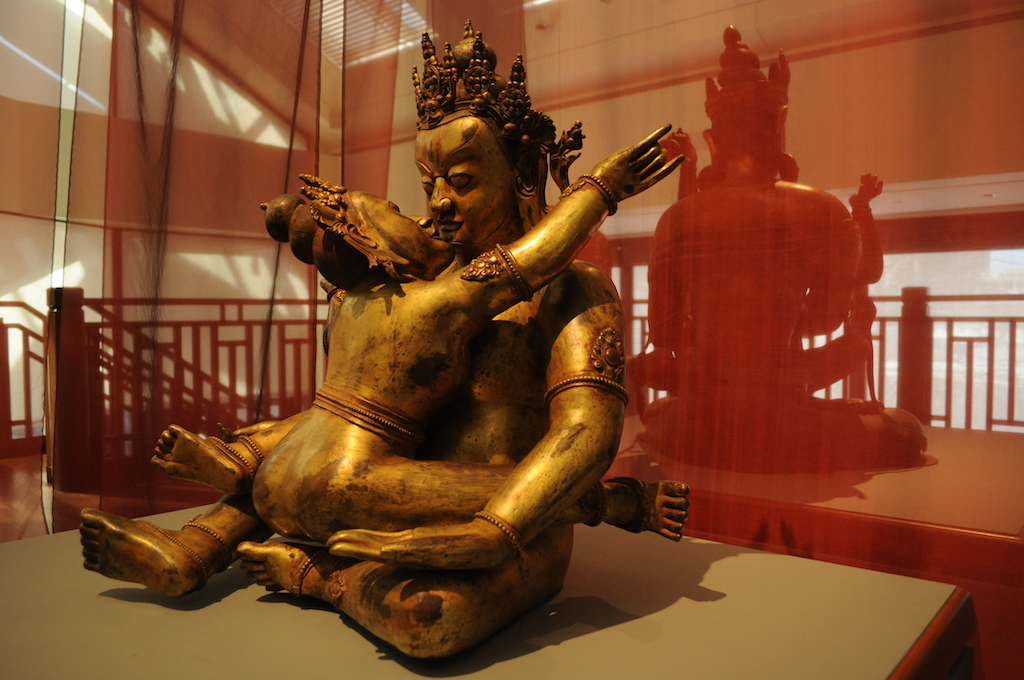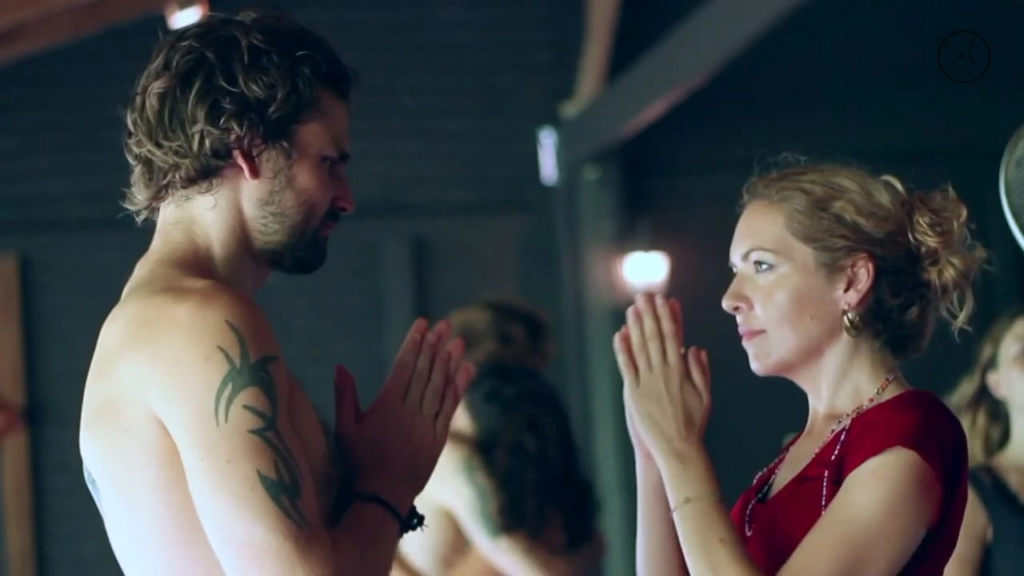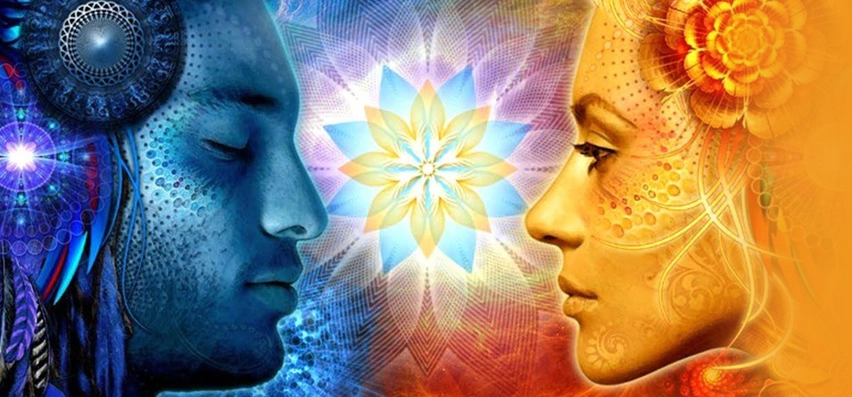Tantra philosophy
Tantra philosophy: the path of depth and connection
Tantra philosophy is a complex and multi-layered system that originated in ancient India and has spread around the world, adapting to different cultures and spiritual practices. Its roots go back more than 5,000 years, but its exact origins and beginnings are difficult to pinpoint. Tantra, derived from Sanskrit, means ‘weaving of cloth’ or, more metaphorically, ‘interweaving of truth and awareness’.
This philosophy represents a holistic approach to life, integrating physical, mental, emotional and sexual well-being, and emphasizes the discovery of the full potential of the human being.
The foundations of Tantra philosophy
Transcending dualism: Central to Tantra philosophy is the understanding that opposites such as male and female, spiritual and material, are intertwined and complementary. Tantra teaches that true spiritual awakening and enlightenment is achieved not through the denial of dualism, but through the integration of its opposites.
The sacredness of all
In Tantra, nothing is considered secular or profane. Everything is seen as divine, including the physical body and earthly pleasures. This view encourages tantrikas (tantra practitioners) to respect and celebrate all aspects of life as part of the divine whole.
Transformation of energy and consciousness.
Practices such as meditation, yoga, rituals and repeating of mantras are designed to uplift and transform one’s basic energy (kundalini) into higher states of consciousness.
Articles
If you have any questions or would like to know more about the tantric lifestyle, please contact me.
Freedom and personal development
It teaches that each person is the architect of his or her own spiritual path, encouraging self-awareness and personal responsibility for one’s own spiritual development.
Tantra philosophy practices
The practices of Tantra Philosophy are varied, including meditation, breathing exercises, pranayama, rituals, yoga asanas and the use of mantras. Sexuality is also an important part of Tantra, but it is only one of many practices aimed at transforming energy and expanding consciousness.
Personal Development and Spiritual Growth
The philosophy of Tantra aims at personal development and spiritual growth. This includes increasing self-awareness, achieving inner peace and developing a deeper understanding of life.
Creating Connection
Tantra teaches the creation of connection not only with one’s inner being, but also with other beings and the universe. It stresses the importance of interdependence and harmony in everything.
Liberation and Enlightenment
The ultimate goal is liberation (moksha or nirvana) – freedom from restraint and a state of awareness in which total freedom and enlightenment are achieved.
There are a number of practices in the application of Tantra philosophy that help to achieve the principles of this philosophy. These include:
- Meditation and breathing exercises, pranayama
- Mantra chanting
- Rituals and ceremonies, created to honor the sacredness of life and connect with higher energies
- Tantra Yoga, combines asanas (yoga poses), pranayama (breathing techniques) and mudras (hand positions) to open energy channels and raise kundalini energy
- Tantra philosophy as a way of life for human beings.
Tantra philosophy is based on the notion that everything in the universe is a unified whole in which every part is interconnected and everything is a manifestation of divine energy. At the same time, it recognises diversity and individual uniqueness, emphasizing that each being and phenomenon reflects divinity in its own unique way.
Unlike many other spiritual traditions, which often see the material world as an illusion or an obstacle to spiritual development, Tantra teaches a deep unity of matter and spirit. The physical world and its pleasures are not something to be shunned, but are tools for spiritual growth and the expansion of consciousness.
The core of Tantric philosophy are the concepts of energy (Shakti) and consciousness (Shiva), which underlie all phenomena. The practices and rituals are aimed at awakening and directing this inner energy to achieve higher states of consciousness and spiritual freedom.
The philosophy of Tantra is a broad
The philosophy of Tantra is a broad and profound subject that encompasses much more than the sexual practices that are often highlighted.
It is a spiritual journey that combines meditation, yoga, pranayama and much more, focusing on increasing awareness, energy and connection.
Tantra has a history dating back some 5,000 years and is deeply rooted in Indian religions and philosophies such as Buddhism and Hinduism. Initially, tantra was a secret practice focusing on spiritual aspects, but over time it came to be associated with sexuality. It is important to understand that tantric sexuality is just one part of a much broader spectrum of practices and teachings that balance different areas of life such as spirituality, health and relationships.
Read more – What is tantra?
Widely known for its depth and complexity, Tantra philosophy offers a unique perspective on life, spirituality and understanding the universe. Often mistakenly limited to sexuality, Tantra actually encompasses a much broader spectrum of practices and teachings that focus on awareness, energy transformation and personal freedom.
Tantra’s historical development and practices have been varied, ranging from the worship and rituals of various deities to deep meditative practices that focus on personal and spiritual development. It is important to understand that tantra incorporates elements of both Vedic and non-Vedic darshanas, combining wisdom and practices from both sources, thus offering a rich and varied spiritual journey.
Read more –Understanding Tantric Philosophy
Tantra has strongly influenced Hinduism, Buddhism and other religious traditions, bringing together ideas and practices that emphasize the sacredness of all life and the universe. According to this philosophy, all aspects of life – from daily activities to sexuality – are sacred and have spiritual meaning. Tantra encourages practitioners to see the world as a divine manifestation, and teaches them to find freedom not through detachment from the world, but through a deeper connection with all that is.
Read more – What is tantra?
The influence of tantra is also widespread in Western culture, where it has inspired art, philosophy and spirituality, although often misconceptions or oversimplifications have been made. The true nature and richness of Tantra is revealed through deeper exploration and practice, opening the door to a different way of seeing the world and experiencing life.
Tantra’s modern practice and teachings continue to be vital, offering guides and practices for those who wish to deepen their spiritual journey and discover the deeper dimensions of life. The study and practice of this ancient tradition can open up new perspectives for personal growth and spiritual awakening.
Read more – Understanding tantra – lecture series
If you would like to dive deeper into the history, practices and contemporary interpretations of tantra philosophy, be sure to check out the following resources, which provide in-depth and comprehensive information on this rich and complex spiritual tradition:
Embracing the Depths of Tantric Philosophy: A Journey Towards Enlightenment
Tantric philosophy, rich with ancient wisdom and relevant for today’s world, offers a unique path to personal and spiritual growth. In this chapter, we explore Tantra’s holistic approach, weaving together life, awareness, and transformation. Join us on a journey to uncover deeper meanings, build meaningful connections, and experience profound change. Let’s discover how the timeless teachings of Tantra can guide us to a more enlightened way of living.
The Foundations of Tantric Philosophy
Though rooted in the distant past, Tantra’s lessons are timeless, addressing modern challenges with ancient wisdom. Drawing from the spiritual traditions of both Hinduism and Buddhism, Tantra extends beyond mysterious rituals to a deep engagement with life itself. In this section, we delve into Tantra’s fundamental principles, highlighting its view of the divine as both within us and beyond us, and how its ritual practices can bring about profound inner transformations.
The Role of Awareness and Connection
Awareness and connection lie at the heart of Tantric practice. Tantra invites us to see beyond our everyday reality through meditation, breath work, and the echoing chants of mantras. We’ll explore how these practices not only increase mindfulness but also deepen our connection to ourselves and the universe around us.
Transformation Through Tantra
At its core, Tantra is about profound transformation—personal evolution and the breaking down of barriers that hold us back. This transformative journey improves not just our own lives but also our relationships with others. This section examines how Tantra pushes us to embrace and integrate our darker sides, leading to a complete and liberated self.
Practical Applications of Tantric Teachings
Tantra is more than just theory; it’s a guide for living well every day. Here, we provide practical tips for integrating Tantra into daily routines, enhancing relationships, work, and wellbeing. From the art of mindful eating to the sacredness of our sexual experiences, discover how Tantra can help balance and enrich your life.
Challenges and Misconceptions
Despite its depth, Tantric philosophy is often misunderstood, obscured by myths of exotic mysticism and sexual rituals. This section clears up these misconceptions, outlining Tantra’s true aims and the ethical boundaries it upholds. We’ll also discuss the hurdles newcomers might face, including how to navigate Tantra’s rich but complex landscape.
The Path Forward
Embracing Tantra means more than studying ancient texts; it’s about applying this wisdom to flourish amidst life’s chaos. As we wrap up this chapter, we reflect on Tantra as a continuous path of learning and transformation. We encourage you to keep an open heart and committed spirit as you explore the profound depths of your mind and spirit. Tantra isn’t just a spiritual path—it’s a way of life that offers deep insights into our existence and our role in the universe.
Best regards,
Urmas Silman
What is tantra philosophy?
Tantra philosophy is a spiritual path and practice that originated in ancient India. The word ‘tantra’ means ‘weaving of cloth’ in Sanskrit, or figuratively ‘the interweaving of truth and awareness’. This approach embraces a holistic view of life, integrating physical, mental, emotional and sexual well-being and emphasizing the discovery of the full potential of the human being.
What are the fundamentals of Tantra philosophy?
Tantra philosophy is based on a number of fundamental principles, including the transcendence of dualism, the sacredness of all, the transformation of energy and consciousness, and freedom and personal development. Tantra teaches that opposites (such as male and female, spiritual and material) are intertwined and that true spiritual awakening is achieved through the integration of these opposites.
How do the practices of Tantra help to achieve its goals?
Tantra practices such as meditation, breathing exercises, rituals, yoga and mantra recitation are aimed at raising and transforming energy (a process called sublimation), expanding consciousness and creating a deeper connection with self, others and the universe. These practices help achieve inner peace, self-awareness and spiritual growth.
How can you begin to learn and practice Tantra?
It is advisable to start learning and practicing Tantra with the guidance of trusted sources and experienced teachers. If you are interested, you can start by reading, attending workshops or courses that focus on the basics and practices of tantra. It is important to approach with an open mind and to be ready for personal growth and discovery.
What is the relationship between Tantra philosophy and sexuality?
Although in the West tantra is often associated primarily with sexuality, this is only one part of the philosophy of tantra. Tantric sexual practices focus on creating a deep connection with a partner and the conscious use of sexual energy for spiritual growth. However, tantra is much more than this, encompassing a broad spectrum of practices and teachings aimed at a person’s spiritual and emotional development.
Book an appointment today
Book an appointment today and take the first step to begin your spiritual and sexual journey of discovery. Whether you’re seeking personal healing, want to deepen your spiritual practice, or are simply looking for a new way to relax and de-stress, tantric massage is a powerful tool on your journey.
Tantra massage in Tallinn
Tantra massage in Tallinn. A voyage of discovery into the world of your deeper femininity.
Tantra Massage, also known as Tantra Therapy, is a holistic approach to our body and sexuality. Tantra Massage combines ancient Tantric teachings and massage techniques, offering a unique way to heal our physical and emotional bodies.
It is an intimate art of bodywork that expands our understanding of sexuality and helps us discover new dimensions of pleasure. At the same time, releasing the physical, energetic and emotional blocks in our bodies.
A woman’s sexual opening in a Tantra massage session
Each day I see in my work women who cannot orgasm at all, can’t have internal orgasms or their sexuality is completely asleep.
Because of that their relationships with their partner’s suffer, also their health and their overall wellbeing. I can see more clearly how important it is to start paying attention to this part of their being, instead of ignoring it. Many men are desperate in relationships.
Full Body Orgasm
Talking about male and female sexuality “full body orgasm” is not so often mentioned.
For many people this is like talking about walking on the moon, they have no idea what it is and if it even exists. Full Body Orgasm When a man or a woman gets an orgasm, then usually they have this intense feeling of release in the genital area. For men it comes with the ejaculation and for women often with the clitoris orgasm, sometimes with the lower vaginal orgasm.
Yoni massage in Tallinn
Yoni massage is a type of Tantric massage that specifically focuses on the female genitalia and reproductive system, known as “Yoni” in Sanskrit, which translates to “sacred space” or “sacred temple.”
In Tantra, the Yoni is seen as a source of life and a place of deep wisdom and pleasure.
Blockage release massage
Massage for Releasing Blockages: A Life Quality Changer
Massage therapy has proven its effectiveness over time in alleviating a variety of health issues. One of the most significant forms of massage is the blockage-releasing massage, which focuses on restoring the balance of body and mind by releasing both physical and emotional blockages.
Marma massage
Marma Massage: Ancient Asian Healing Art
Originating from traditional Indian medicine, Marma massage is a unique therapy that combines ancient wisdom and modern techniques to offer a holistic approach to mind-body health. This article delves into the world of Marma massage, discovering its origins, techniques and benefits.
What does the phrase Tantra Man mean
For many people the meaning of the mystic-sounding phrase Tantric man is quite unknown.
It sounds somewhat unearthly and many woman dream about a Tantric man entering their lives who should somehow magically solve all of her problems and make her happy at long last.
Tantric massage and Polarity
The whole universe and all forms of life within it are working as a mutual interaction of positive (+) and negative (-) energies.
Starting from the energetic (+)/(-) connections at the atomic level, forming the tangible and realistically comprehensible matter, up to the rather elusive solar system and galaxies.
Tantric massage and Menstruation
Once a month, on an average, women have a menstrual cycle of varying length and often a massage session coincides with the cycle.
Menstruation For most women this creates an unpleasant situation where they would like to come to the session but are afraid because they have feelings of shame and embarrassment related with their menstruation.
Anima and Animus
Anima Derived from Latin meaning “a current of air, wind, breath, the vital principle, life, soul”, the Anima refers to the unconscious feminine dimension of a male which can often be forgotten or repressed in daily life.
However, in order to psychologically progress and reach greater internal balance and harmony, it is necessary for a man to recognize, embrace and connect to this latent element of his character.
If you have any questions or would like to know more about the tantric lifestyle, please contact me.
Services
Courses
Contact
Urmas Silman












